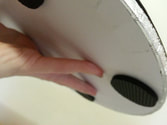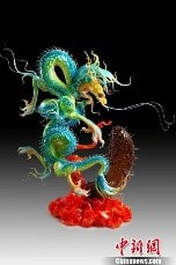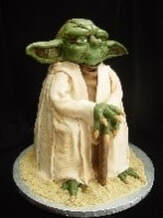|
What is meant by gravity defying? A gravity defying cake is one where it seems impossible for the cake/work displayed to stay in position. It almost feels like it may topple over and does not seem to have any visible support to hold it. The supports are internal and must therefore be of food grade quality. The gravity defying parts must be substantial enough to be cut and eaten as a cake and this makes it different from a sugar art piece. What is a sugar art piece? Sugar art is an ornament, sculpture or other decorative item made from sugar. It is intended to be artistic and decorative only and not eaten so it can have a lot of internal structures even wire and wood which are not food safe. This makes it different from a sculpted or sculptured cake. Sugar art can come in many shapes and sizes, such as people, animals, buildings, flowers or novelty items. In competitions where the Schedule states, Sugar Art, Creative Sugar Art or Imaginative Sugar Art the item is not to be displayed on a cake, but on a suitable stand only. What is a sculpted or sculptured cake? This is a cake which has been carved into a shape representing something but is still intended to be cut and eaten as a cake. It could also, but not necessarily have some gravity defying elements in it.
0 Comments
Why is butter cream not allowed in competitions? Wilton Wilton The problem is that because butter cream melts and slumps so easily it is necessary for shows to have refrigerated cabinets available to display the cakes. Making it even more difficult for a show committee is that the moisture in the butter cream can cause fondant decorated cakes to deteriorate so they need to be in separated cabinets. There is nothing wrong with buttercream, it is a very popular cake decorating medium at the moment and judges are very happy to judge it but you can imagine that many show committees are not able to provide these suitable facilities for displaying the competition cakes so that is why butter cream is often excluded. What is meant by handwork only in a schedule?Why do some competitions ask for a technical information sheet?This helps a judge understand anything which is not obvious to the eye in your entry and helps the judge know that you have complied with the schedule. This could be internal supports which are hidden from view, or edible products which may look incorrect. You would describe the food safe materials used for an internal support or list the brand name of edible gold, silver or glitter products used. Sometimes you may have made your own moulds or used an unusual flower which may not be recognised and it helps the judge to know this. Who writes a schedule?The show organisers are responsible to write the schedule and this is frequently done in consultation with the Guild or other cake decorating bodies to keep it up to date with
new techniques and trends. Can I use rice paper or wafer paper on my competition entries?Yes, you certainly can in NSW competitions. The judges of the Cake Decorators Guild of NSW consider that all edible products are accepted. Entries that incorporate wafer paper or rice paper will be judged according to the skill of their execution and the quality of the finish just as sugar decorations are, so beautifully executed wafer paper flowers would not be disadvantaged. However…
RICE PAPER SAILS WAFER PAPER FLOWERS
 Judges in New South Wales work to a code of practice set out in the Competition Guidelines for Organisers, Stewards, Judges and Competitors which was developed by the Australian National Cake Decorators’ Association Incorporated. The NSW Guild contributed to this publication and runs annual workshops to keep up to date with any developments in cake decorating and practice the judging process. Judges may and do enter competitions but they may not enter a competition where they are the only judge nor can they judge a class in which they have exhibited. Judges must understand the schedule of any competition they are judging but it is not their place to decide whether or not an entry is allowed in the competition. It is the role of the Head Steward to assess entries on submission and check that they comply with the schedule. The Head Steward is also the point of contact for questions prior to submitting an entry. A number of definitions have been developed over the years to help competitors, judges and competition stewards work with a competition schedule and enter competitions. CAKE: Is an exhibit of a size required by the competition class, or at least able to serve a number of people. A cake must be free of non-food safe or toxic elements but where needed can be supported with appropriate food safe structure.  SUGAR ART PIECE: Is an ornament, sculpture or other decorative item entirely made of/from sugar. It is intended to be artistic and decorative. Because these are not intended to be eaten or come into contact with a cake they may utilise non-food grade supports.  As the schedule for the second virtual competition has just been released we thought it might be helpful to have a chat that could help people when they are putting together their thoughts and entries. Before beginning the entry it is important to read the schedule carefully to make sure your entry will fit within the criteria set down. Cake In this competition the cake has a measurement specified. Measurements are generally the horizontal measurement so for this 25cm cake it is the width of the cake. The height is not restricted but as it is a single tier cake it would not include stacked or multi tiered cake. The shape is not specified so your cake could be round, square, rectangular or oblong but the measurement of 25cm must be along the front of the cake when you present it on its board. So, a 25cm diameter round cake, 25cm square cake, a rectangle no longer than 25cm on the long side or an oblong which is 25cm along the long part. The board size is not included so you can be flexible in proportion to the cake itself. Biscuits There is no specification for the biscuits apart from the number, being six, so you can use either purchased or homemade biscuits and you can decide what shape you want, either plain or innovative. The only stipulation is that they must all fit on an A4 sized piece of card or board. The Topper The topper is in the Sugar Art Section so this is an ornament, sculpture or other decorative item entirely made of/from sugar. It is intended to be artistic and decorative. It can incorporate any of the ribbon, tulle etc. listed under the rules. As it is intended to be put onto a cake it should not have any non-food grade supports exposed to the cake surface. For this competition it does not need to cover the whole of the 25cm cake but must look appropriate/suitable for this size. Photographing your exhibit We know that you are cake decorators not photographers but keep some simple things in mind so that your photograph shows the entry as best you can. Putting it against a plain background is a good idea and choose a colour that allows your entry to stand out and not distract from it. Blue and grey seem to work well but something that goes with your colour scheme is fine. You could consider standing back from the exhibit to get a wider shot that you then crop but don’t sweat on this if you are not comfortable – we really do understand that technology is not for everyone and having your entry in the competition is the main thing! Head Steward receives your entries and is also available to answer questions before you submit your entry. For this competition the Head Steward is Joy Eagles – [email protected] Show and competition time is well upon us once again! Here are some of the questions or problems you could be asking yourself:
1. Do I really want to do this? Am I prepared to put in the time that it takes – it really does take quite a bit of time. 2. Do I have the knowledge? Knowledge comes from asking questions of ANYONE - friends, members of your local branch, people in You're not the first person to ask questions and won't be the last. Everyone who has entered a show will have been in the same predicament at some time. 3. Do I have the skill to do this? To be honest, maybe not, but if you start with a "Oh! I’ll never win because so and so will enter” you will never find out. 4. Do you want to win 1st prize in your class? Of course you do, and if anyone tells you they don't, why on earth are they entering? It’s only human nature to want to win! After all that's what a competition is about. Finally - Enter a competition because you want to Enter a competition because you want to learn Enter a competition because you want to have some fun So now we have the first hurdle cleared you can work out what section you want to enter EXPRESSIONS OF INTEREST FOR JUDGES TRAINING 2019/20
Expressions of interest are sought from those Members who wish to participate in the next Judges training course to be held when sufficient applications have been received. The course would involve three weekends at a venue in the Sydney metropolitan area at your own expense. A fee will also apply for the course. Once trained Judges attend an annual professional development day to update themselves. Throughout the year Judging assignments are mostly at their own expense. Application involves a written CV with accompanying photos. For further information please contact:- Joy Eagles: - Phone 02 6344 8345 Mobile: - 0428 422 431 or email Joy  So you're thinking about entering an in-branch competition/local show/The Royal/Challenge. What do you need to know? Well, the first thing you need to do is read the Schedule. For example the Schedule will give you information as to:-
One part of the Schedule that is often missed by competitors is "cleats"! What is a "cleat"? CLEATS Also known as runners or legs are used to raise the base board Cleats are used for ease of handling and prevent damage when trying to lift an exhibit. When a Schedule states "CLEATS MUST BE USED" this refers to the base board or the board that comes into contact with the exhibition case or surface (except where the Schedule states otherwise). A cleat should be a minimum of 5mm or what is stated in the Schedule. What can I use as a cleat? You can buy self-adhesive cleats at cake decorating shops, use another smaller base board or buy a length of pine, say from Bunnings, cut into small lengths or any other suitable items that will allow the exhibit to be moved more easily. Cleats can be covered with paper, fabric or painted. Remember Judges are cake decorators too. We would like to encourage you to enter a competition. We do appreciate and understand the amount of time and effort, sleepless nights and self doubt that you go through when making a competition entry. Never feel that you can't ask a question, you can always contact the Registrar or there will be a contact person to ask for the specific competition you are entering. 1) In a point system of judging, the competitors and judges must abide by the rules. With the point system, a predetermined number of points are given for presentation, visual appearance, difficulty of technique, use of colour and creativity, etc. The cake with the highest points is the winner. 2) In special classes there a number of judges and each judge evaluate the cakes or sugar art in a category then confer to reach a final decision. "If Cake Decorating & Sugar art competitions didn't exist, many of the skills, techniques could disappear and that would be a shame."
|












